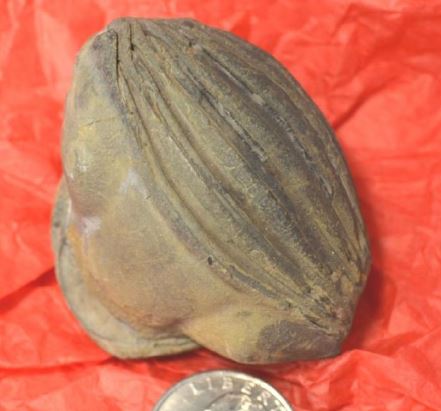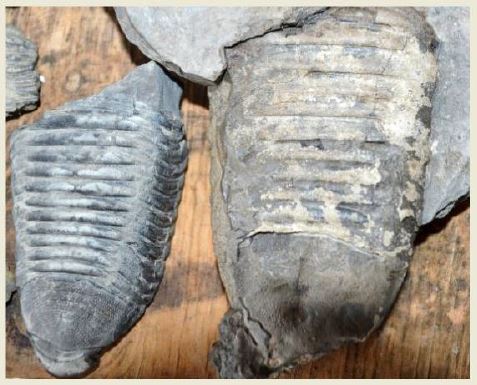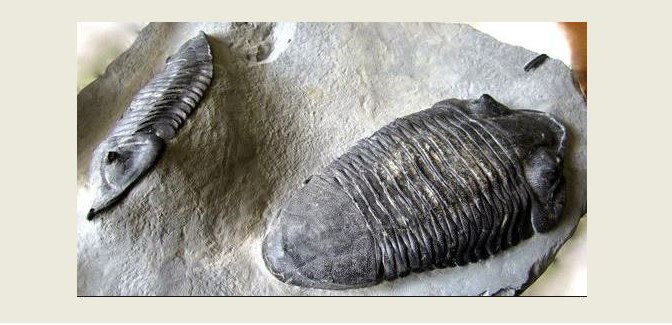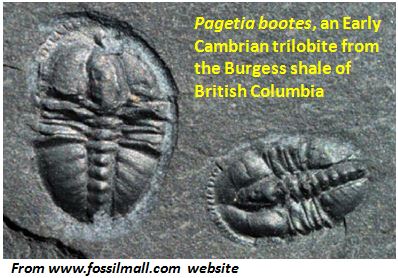A Middle Devonian Trilobite of New York State By Stephen Mayer
Stephen Mayer is a member of the Wayne County Gem and Mineral Club and wrote this piece for the March 2015 newsletter. It is certainly an informative and appropriate entry for my blog and with Stephen’s permission I have included it.
Whether collected by oneself in a creek bed, road cut or quarry or just simply observed in a museum’s exhibit, trilobites have fascinated people for thousands of years. Excavation of early burial grounds 50,000 years old have revealed trilobites with human remains (AMNH, 2015). Their fossil forms have been the basis of numerous studies by everyone from paleontologists to school children.
Trilobites are extinct arthropods distantly related to the modern marine lobsters and horseshoe crabs. In the Burgess Shale in the rugged high peaks of the mountains of British Columbia, Canada an amazing group of soft-bodied organisms have been found including Trilobitamorpha – fossils that appear to be like trilobites but just have not fully evolved yet. Then true trilobites first appeared during the Cambrian Period about 521 million years ago during the “Cambrian Explosion” as a result of the development of a chitinous exoskeleton which permitted fossilization of these organisms.
Trilobites became one of the most successful groups of organisms, surviving for almost 270 million years before becoming extinct at the end of the Permian. More than 20,000 species have been described with diverse anatomical features as complex eyes and spiny appendages to blind simple forms. They ranged in size from a few millimeters to a couple of feet long. Some trilobites were nektonic (swimmers) while others were epifaunal (living on the sediment substrate). There were also infaunal species that burrowed in the sediments. Some were active predators while others were more passive detritus feeders.
The scientific classification of trilobites is broken down from Kingdom Animalia, Phylum Arthropoda, Class Trilobita, and then into as many as ten Orders. This paper will focus on one trilobite in the Order Phacopida. The species Dipleura dekayi was first described by Green in 1832 from a locality in the Middle Devonian (Givetian) of the Hamilton Group of the Skaneateles Formation in New York.
Dipleura dekayi commonly occurs in the sandy shales and shaly sandstones in eastern Onondaga and Madison Counties of New York at the base of the Delphi Station Member of the Skaneateles Formation (Cooper, 1935). Specimens are somewhat less common but may also be found scattered in siltstones throughout the rest of the Hamilton Group. Individual specimens of Dipleura dekayi can reach about 15 cm (6 inches) in length attaining adult characteristics at about 11-40 mm (.38 – 1.5 inches).

The most notable characteristics in the adult are the presence of segmentation only on the thorax with the complete loss of segmentation on the glabella and pygidium, as well as the loss of the thoracic axial lobe. The immature forms have the axis well developed on the thorax and tail and have a strongly segmented glabella (Cooper, 1935). The eyes are somewhat raised above the glabella suggesting an adaptation for better vision. Riccardo Levi-Setti (1995) speculates that the turret-like eyes of many trilobites protruding from the cephalon could have
been useful as watchtowers above the seafloor while still concealing of the hunter below a layer of sand. From this vantage point, a surprise attack on an unwary prey would certainly lead to a tasty meal. This mechanism for feeding has been observed in some modern crustaceans including the deadly Mantis Shrimp.
In summary, trilobites were a marvelous evolutionary success in which Dipleura dekayi was just one species. Although extensive research has been completed on trilobites, much can still be learned from this fascinating group. Happy hunting.
References:
Cooper, G.A. 1935, Young Stages of the Devonian Trilobite Dipleura Dekayi Green, Journal of Paleontology, Vol. 9, No. 1 pp. 3-5.
Levi-Setti, Riccardo,1995, Trilobites. The University of Chicago Press, 2nd ed., p. 342.
WWW.AMNH.org/our-research/paleontology/faq/ trilobite-website, 2015. Twenty Trilobite Fast Facts.
MY ADDITIONAL NOTE:
It is perhaps worth noting that fine specimens of Dipleura dekayi have been found on two recent Wayne County Club digs.




